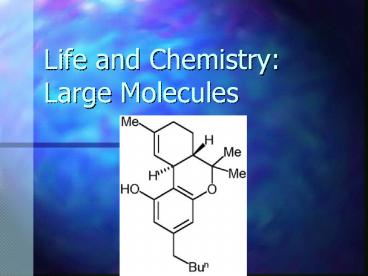Life and Chemistry: Large Molecules - PowerPoint PPT Presentation
1 / 47
Title:
Life and Chemistry: Large Molecules
Description:
Life and Chemistry: Large Molecules Macromolecules monomers are linked together to form polymers dehydration synthesis (condensation) broken apart via hydrolysis ... – PowerPoint PPT presentation
Number of Views:39
Avg rating:3.0/5.0
Title: Life and Chemistry: Large Molecules
1
Life and Chemistry Large Molecules
2
Macromolecules
- monomers are linked together to form polymers
- dehydration synthesis (condensation)
- broken apart via hydrolysis
- function is related to structure
3
(No Transcript)
4
(No Transcript)
5
(No Transcript)
6
Macromolecules
- 4 classes of biological macromolecules
- proteins
- carbohydrates
- nucleic acids
- lipids
7
(No Transcript)
8
Proteins
- polymers of amino acids
- functions include
- structural support
- catalysis
- transport
- defense
- movement
- regulation
9
Proteins
- each amino acid contains the following
- ? carbon
- H atom
- amino group
- carboxyl group
- side chain
- provides unique chemical properties
10
(No Transcript)
11
(No Transcript)
12
(No Transcript)
13
Amino Acids to Proteins
- peptide bond
- joins two amino acids
- carboxyl group of one bonds with amino group of
another - 20 used to make every protein
- each distinguished by its side chain
14
(No Transcript)
15
Protein Structure
- 4 structural levels
- type, position, and number of amino acids
determine function and structure - primary structure
- sequence of amino acids comprising the protein
- huge variation possible
16
Protein Structure
- secondary structure
- regular, repeating patterns as a result of
H-bonds - ? helix
- ? pleated sheet
17
(No Transcript)
18
(No Transcript)
19
Protein Structure
- 3. tertiary structure
- results from interactions between R groups
- final 3-D structure of a single protein
- 4. quaternary structure
- arrangement of protein subunits into a large
macromolecule
20
(No Transcript)
21
(No Transcript)
22
(No Transcript)
23
(No Transcript)
24
Environmental Effects on Proteins
- structure affected by
- pH
- temperature
- denaturation
25
(No Transcript)
26
Carbohydrates
- primarily C, H, and O
- 121 (CH2O)
- functions
- energy source
- structure
27
Carbohydrates
- 4 categories
- monosaccharides
- disaccharides
- oligosaccharides
- polysaccharides
28
(No Transcript)
29
(No Transcript)
30
(No Transcript)
31
(No Transcript)
32
(No Transcript)
33
Lipids
- no polymers
- nonpolar hydrocarbons
- hydrophobic
34
Fats and oils
- triglycerides
- composed of fatty acids and glycerol
- fats vs. oils
- saturated vs. unsaturated
- energy storage
35
(No Transcript)
36
(No Transcript)
37
Phospholipids
- composition
- 2 fatty acids
- phosphate containing polar head
- forms biological membranes
38
(No Transcript)
39
(No Transcript)
40
Steroids
- composed of 4 fused carbon rings
- functions
- part of membranes
- hormones
- development
- ion balance
41
(No Transcript)
42
Nucleic Acids
- nucleotide structure
- 5-C sugar
- phosphate group
- nitrogenous base
- function
- storage, transmission, and use of genetic material
43
(No Transcript)
44
Nucleic Acids
- 2 types
- DNA
- information storage
- RNA
- transmission
45
(No Transcript)
46
(No Transcript)
47
(No Transcript)































